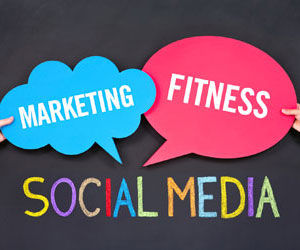
It used to be a good idea to go “all in” with social media, meaning you employed every available channel to market your fitness business, taking advantage of each platform’s unique features. Now social media is moving so quickly that it’s less feasible for most health and fitness professionals to keep up. Even within one platform, like Facebook, the possibilities for what to post are beginning to exceed what many people have time for: In addition to the usual Facebook posts (links, photos, etc.), you can produce slideshows, gifs, recorded video with subtitles, live video from mobile, live video from desktop, 360-degree images, sponsored posts, Facebook Stories, and on and on. Add to that, Snapchat, Instagram, Pinterest, Twitter, Flickr, LinkedIn, YouTube and whatever apps/websites get a turn in the spotlight before they ultimately shut down (R.I.P.: Vine).
You know what? There’s too much out there for you to tackle it all. If you’d rather be training clients, but feel an unpleasant pressure to do everything there is to do on social media, you put yourself in jeopardy of getting little accomplished. A better approach: making highly strategized choices about how and where you use social media for business. Here’s how to make the best use of your time without becoming overwhelmed by the constantly emerging choices and new directions.
Pick Your Platform(s)
Think about your professional role in the fitness industry. Like most qualified health and fitness pros, you probably have solid knowledge of the big picture of health and fitness. But you might also specialize in more narrowly defined areas—such as young athletes, women’s fitness, weight loss, older adults, etc. This is where you devote most of your education, effort and time. No one expects a fitness pro to be equally versed in rehab and Zumba and CrossFit and triathlons and kids’ fitness. We specialize to get really good at a few things. Fortunately, you can do something similar with social media. But how?
Most likely, your target audience gravitates to a few specific sites/apps—perhaps this is reflected in higher follower numbers there. Post to these networks the most. You’ve probably also already discovered that you like some networks more than others, perhaps because they yield the best results. It's O.K. to streamline your best efforts to a handful—maybe two or three—channels. The goal is to minimize your workload and maximize your efficiency—without the guilt of feeling like you aren’t keeping up. Take a hard look at your social activity. Are you pinning to Pinterest when, really, your most loyal audience is on Facebook or Instagram? What has Twitter or Snapchat done for you lately?
Size up each account and how it plays a role (or doesn’t) in helping you attract business, promote your brand, communicate with your customers and educate others about health/fitness. Streamlining social in this way is useful as long as you aren’t hasty in your decision to leave some sites behind. You wouldn't want to cut or decrease activity to a potentially worthwhile account just so you can cross it off your list. Check out the sidebar, “Guidelines For Prioritizing Your Top Social Channels,” for advice on deciding which accounts to prioritize, which to possibly ditch and which to simply scale back on. (Of course, if you enjoy social media and find it fruitful to frequently post on many platforms at once, carry on.)
Find Your Favorite Features
Within each social platform, you’ll find a myriad of features that just keep getting more sophisticated. Unfortunately, many health and fitness pros who use social media every day overlook, or don’t even know about, features designed to make their marketing efforts less time-consuming and more effective. If you’ve committed to some channels over others, it’s smart to then take stock of the best posting options available to you.
First, update all relevant social media apps on your phone/tablet. Without the most updated app, you might miss out on helpful new features. Take 15 minutes to explore your most-used social sites, on both mobile and desktop. Sometimes, a few features available on desktop won’t appear on mobile, and vice versa. Know your options and where to find them.
Next, act as if you’re about to publish a post, taking note of all the posting options that pop up—there might be more choices than you think! For example, on Instagram, you can publish a photo, video, photo collage, slideshow containing both photos and videos, or a Boomerang (i.e., a mini video that loops back and forth). There are also Instagram Stories, which are separate from your main gallery of photos/videos. Over time, try out all the options, tracking which ones get the best response. You might find that some posting styles mesh better with your brand than others. For example, Instagram Stories and Facebook Messenger Day transmit an amusing, in-the-moment vibe. A live video broadcast can either come across as candid or businesslike, depending on how you convey it.
Finally, don’t leave it to chance that you’ll hear about new features as they develop. Stay on top of the news: Most major social sites have a blog or online news page that publishes updates and tutorials when new features roll out. There are also numerous online resources for keeping up to date. See the sidebar below for a few leads.
Where to Find Out About Social Media Updates
Repurpose Everything
If you’ve ever been hesitant to post the same piece of content—a photo, video, link to a website/blog—more than once on social media, don’t be. It’s crowded out there, making it next to impossible for all of your followers to see everything you publish every time. Sharing the same information or image on multiple occasions, perhaps at different hours or days and on all your top social channels, increases the chance that more people see and benefit from your posts. Remember, you can always retool content that might already be familiar to your followers by using a variety of tactics, such as repurposing photos into a collage, gif, slideshow, meme with text overlay or short video with special effects (check out the Lumyer app for this last trick).
Another repurposing approach is to “bundle” your content production. For example, when taking snapshots at the gym or outdoors for social media, make an informal photo shoot out of it so you can double down on the time and effort it takes to set up the location and ensure good lighting. Here’s a hack: Change outfits a time or two during the shoot so it looks like the photos weren’t all taken on the same day. While you’re at it, film a few videos or broadcast live with an exercise demo on the equipment you’ve already set up. The end result is you’ll have a bank of suitable content at the ready. These timesaving strategies help create a consistent flow of content without your having to start from scratch every time.
As you can see, there’s no need to spread yourself too thin, which can minimize the positive results you might expect on social media. Save yourself time by streamlining your focus and efforts to the social accounts, features and strategies that are most relevant and effective for you and your audience.
Guidelines for Prioritizing Your Top Social Channels
Consider the following recommendations when deciding which social channels are most important for your fitness business.
- Look at the numbers. If Instagram is your most popular and active account, make it your priority. You can still continue posting to other platforms, but perhaps not as often.
- When using social media for business, don’t delete an account just because you lack followers or don’t like the platform. If your target audience uses that network a lot, stick with it.
- Check into which networks are forecasted to grow—these are ones to take a second look at. For example, Instagram is still steadily gaining users (especially as it continues to adopt Snapchat-like features), whereas Twitter’s growth has been sluggish for some time.
- Facebook is still by far the largest social network. A lot of your clients (and their friends and family) probably go there, perhaps every day. Unless you have a specific reason to ignore Facebook, it’s probably best to keep using this one, even if it’s not your top priority.
- Consider how to employ certain channels as a low-maintenance “supporting cast” to your main channels. For example, you can quickly drop all the videos you show on Facebook and Instagram into a YouTube channel, as well.
- When a new app or website suddenly hits it big, you might wonder if you should jump on board. You could maybe sign up for an account to secure the handle you want, but just observe at first. Not too long ago, many online marketers made a big fuss about gaining followers on live-streaming apps like Meerkat and Blab. Well, both those apps are long gone. Facebook’s live video now does what they did, and with a large audience already in place.
- If applicable, consider buying advertising to breathe life into one or more waning accounts. Facebook has quite robust capabilities for advertising directed to its site and Instagram, which Facebook owns.





 by
by 




